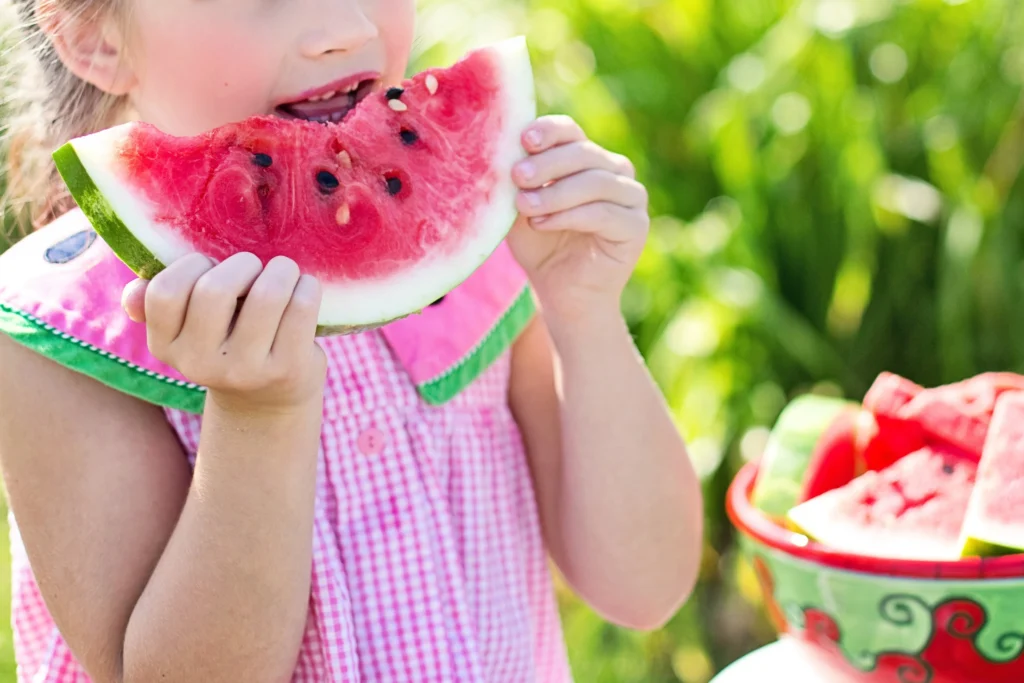Laying the groundwork for intelligent dietary trends for American children is a vital interest in their prospects. As the experience of increasing physical growth and its associated unexpected problems accelerates, the desperation for activity in sustenance and family wellbeing becomes more evident than ever. This guide is intended to prepare caregivers, instructors, and nutritionists to take proactive steps toward promoting and instilling a culture of good nutrition that can improve children’s lives immediately and in the long run. American Children
Introduction
Proper parenting is a fundamental part of a young person’s life as it develops and improves. It affects everything from actual development to mental abilities and educational processes. Instilling intelligent dietary habits early creates a reason for a balanced lifestyle that can prevent medical problems and establish a positive relationship with food. American Children
Step 1: Setting a Positive Example. American Children

Actions are often more potent than words, especially with children. By teaching the intelligent avoidance patterns of behavior we want to instill in ourselves, adults can provide children with solid guidelines to consider.
Patrons can focus on adjusted dinners; not only is it great for you, but it’s also enjoyable to show off that quality food.
Model: When parents choose hearty servings of mixed greens filled with various vegetables over less nutritious choices, they quietly demonstrate the value and business-as-usual of choosing new, whole foods. American Children
Setting a positive role model goes beyond just having a nice dinner. This usually involves maintaining a nutritious lifestyle. Research shows that children who see their caregivers set aside a few minutes for breakfast, make adjustable plates, and eat foods grown from the ground are bound to adopt these trends. An American Institute of Pediatrics review suggests that children’s eating habits are primarily shaped by food patterns displayed by mentors and parental figures. American Children
Despite the day’s trends, creating a culture that doesn’t spoil a particular diet is all about balance and balance—understanding the ‘why’ behind smart dieting is beneficial, supporting the need for nutritious food sources and the appeal of being active and feeling significantly better. Experts also highlight the importance of consistency and persistence, as juveniles often need opportunities for new food sources before they can tolerate them. American Children
Reminding young people of the food preparation cycle can also help with these positive behaviors. Involving them in grocery shopping and dinner preparation teaches them about nutrition and makes good nutrition a common, enjoyable family experience. Dr Yvonne Kelly, from the Organization for the Study of Disease Transmission and Medical Services at College School London, says, “Family dinners and their celebrations are an under-appreciated milestone to guarantee the improvement of smart dietary habits in young people. can be proven.” Thus, it is not just about food decisions but about the intuitive and predictable climate in which they are introduced. American Children
Step 2: Creating a Healthy Food Environment

The openness of nutritious food choices at home pushes children to make better decisions independently.
Stocking the storage room and cooler with good food reduces the passion and simplicity of polishing off handled snacks and sugary drinks.
Real Success: The idea proved viable in a home where processed snacks were replaced with new natural products, significantly increasing children’s daily consumption of leafy foods.
Establishing a good food climate rises above the confines of the storage room and envelops the general food atmosphere within which a young person works. Focuses on characterizing the meaning of a stable climate in shaping child food trends and consumption patterns. American Children
Research Knowledge: The Diary of Pediatrics shares findings on how work climates influence a child’s eating habits. Research has found that when leafy foods are made more open at home, children eat them. This suggests that mentors and gatekeepers can influence young people’s food decisions and organize salient, simple, better choices to access these areas. American Children
Additionally, experts support the implementation of a structured feasting schedule, as it plays a vital role in encouraging better dietary patterns.
Setting specific times for treats and snacks helps children anticipate their meal plan, reducing the chance of hasty, unfortunate moves.
A well-educated assessment: Dr. Jane N. Yawn, a pediatrician, realizes, “Routines provide youngsters with a sense of security, which, when applied to eating patterns, leads to better food choices. It gives me more confidence.”
Additionally, scientists at Cornell College’s Food and Brand Lab found that children who ate their meals at a standard dining location, such as the family dinner table, as opposed to the TV, generally made better food choices. But they will settle because they know more about their food—the meal. American Children
While creating a solid climate, it is equally important to shed light on irrational decisions and to offer various supplemental fat foods. Decision confusion can lead to hesitant or unfortunate decisions, so reframing can reinforce better eating patterns. American Children
KEY POINT GUIDE: Pediatrician Dr. Laura Watkins points out, “A large number of these decisions can overwhelm a young person, but having a ‘rainbow plate’ where decisions are beautiful, varied and healthy is a dynamic cycle. I can improve.”
By incorporating research-supported practices with verifiable accountability for suitable food climates, mentor and parent data can give young people a solid framework for developing deep-rooted healthy eating patterns. American Children
Step 3: Teaching Balanced Nutrition

Understanding healthy needs empowers young people to know why they should make quality food decisions.
Integrating fun exercises around different types of nutrition teaches young people about the benefits that other organic produce, vegetables, and proteins bring to their bodies.
School involvement: A primary school developed a garden with a strong focus on how to reach clear conclusions about dirt and self-service counters, working on students’ eagerness to try entirely new vegetables. to do
Education System and Health Skills:
Integrating healthy instruction within school education plans can be a strong starting point for advancing a comprehensive understanding of diet and its effects on health. Well-educated assessments: Health therapist Dr. Emma Clarkson describes the importance of this early training, “When young children receive predictable and clear data about parenting, they can engage in informed decisions. that persist into adulthood.” She recommends schools use evidence-based programs like ‘MyPlate,’ a USDA-funded program that works on the types of nutrition in an engaging and straightforward setting for young people. American Children
Education Plan Adoption: A school district in Maine embraced this drive by implementing the ‘MyPlate’ program, which significantly improved children’s choice of adjusted dinners in their cafeteria. Students were empowered to describe the importance of each food category and effectively participate in planning feasts that included a variety of food choices. American Children
In addition, research indicates that teachers and mentors are highly influenced by supporting these instructional messages. The influence of the local area: A review of the ‘Diaries of School Wellbeing’ suggests that local area-based interventions, including guardians and school staff, can help children practice what they know about wellbeing at school and home. American Children
Additionally, encouraging judgmental consideration of food advertising and media education can help children become keen shoppers who resist the allure of undesired food displays. Media Literacy Contribution: The Middle for Science in the Public Interest advocates for media education schooling, showing young people how advertising influences their eating decisions and the underlying health issues of foods. How is the survey conducted? American Children
By adjusting instructional methods to support local area and media expertise, these essential steps toward demonstrating altered nutrition are poised to help American children develop good dietary habits that will keep them throughout their lives.
Step 4: Making Mealtime Enjoyable

Encouraging affection for good nutrition can be as fundamental as making dinnertime a wonderful, family-focused occasion.
Empowering children to engage in cooking and setting the table gives them more resources to eat.
Family Night: A family that dedicated one night seven days to cooking together saw their children’s eating habits improve and family bonding increased.
Despite the pleasant past, here are the extended nuances associated with making dinnertime acceptable:
Involving children in arranging the feast likewise sparks their interest in what they eat. A well-educated assessment: Renowned pediatric dietitian Samantha Roberts advocates this proactive approach. She notes, “When kids help plan and organize their own feasts, they’re more excited about eating quality foods because they feel responsible for what they’ve made. “In addition, casual conversation during dinner can serve as a teachable minute where patrons can review the medical benefits of the food at the table, seamlessly creating optimal dietary patterns. American Children
Setting themes for dinner, such as ‘Tropical Tuesday’ or ‘Whole Grain Wednesday,” offers a pleasant assortment consistent with nourishing goals while adding energy to the week’s feasts. Imaginative Meal Plans: Culinary expert and parenting advocate Marcus Samuelsson shares the effective results of schools that have introduced themed dinner drives into their lunch programs, noting that “The articles Making it fun and at the same time exposing the youth to different styles of cooking from the surrounding sounds. The world is expanding its palate.” American Children
Celebrations of small achievements, such as trying another vegetable or choosing water over pop, can validate solid decisions and empower impulsive behaviors. Consistent encouragement: Pediatrician Dr. Patricia Kohl suggests, “Recognition and encouraging feedback around mealtimes can significantly influence a child’s confidence and willingness to investigate nutritious food sources.” American Children
By adopting these methods, mentors and instructors can help instill a critical appreciation for good food sources within a child’s daily existence. American Children
Step 5: Developing Healthy Eating Habits for Life

Goal-setting exercises that children can carry into adulthood. Mindful eating, estimating appropriate portions, and limiting distractions are essential to developing a supportive and solid relationship with food.
Helping teens pay attention to their hunger cues and partake in their treats without the distraction of screens can promote better eating patterns.
Precautions: A family drive to eat at the dinner table without interruption helped children focus on their food, leading to better motivation and snack control.
Equipping young people with the knowledge and skills to choose and cook healthy food sources is fundamental to developing good long-term dietary habits. Cooking Skills: Showing children how to prepare basic, nutritious meals enables them to make better food decisions. A well-educated assessment: Culinary gourmet expert Anne Cooper illustrates the impact of preparation instruction on children’s eating habits. “Once kids learn how to cook with new things,” she says, “they develop a preference for real food, and the processed choices become less appealing.” American Children
Increasing the tendency to understand and understand food names can help young people make informed decisions about what they eat and drink. Nutritional skills: Individuals who integrate exercise into school health instruction report making more knowledgeable food choices. A dietitian’s perspective: Registered dietitian Rachel Johnson, Ph.D., realizes, “When teens understand how to use food labels, they’re essentially evaluating the food. gain the ability to control what they eat and gain the confidence to settle on better choices.” American Children
Regular family dinners can also have significant benefits, as they provide a setting in which caregivers can demonstrate smart dietary habits and encourage open conversations about great nutrition. Parenting influence: A review in the ‘American Diary of Preventive Medication’ found that regular family feast times were associated with higher consumption of leafy foods in adolescents. Master understanding of nutrition: Dr. Barbara Fiese, a family clinician, suggests, “Family dinners are a vehicle for parents to demonstrate acceptable meals and disseminate food concepts and dietary trends that youth can experience. ” American Children
Schools offer nurseries as a productive experiential learning tool where children participate in preparing their food. Cultivation training: Schools with garden programs often see a marked increase in students’ inclination and use of soil products. Expert Training Talk: Nature teacher David Sobel notes, “School gardens and the learning involved build a connection to food sources and lead to better food decisions over a long period of time.” American Children
By strengthening these practices, children in America can develop a positive and mindful relationship with food, laying the foundation for sound nutrition to help their future prosperity.
Conclusion
These five steps toward promoting good dietary habits among American children are neither easy fixes nor foolproof measures, but they are essential and can yield significant benefits when applied persistently. They massively support genuine wellbeing, upgrade the mental turn of events, and advance a long period of innovative diet trends.
For additional assets, mentors and instructors can investigate audio recipe books, customized baby sustenance sites, and online classes detailing smart dieting for youngsters. Through shared responsibility and training, better opportunities are accessible to our youth. American Children
FAQs
What are the key benefits of promoting healthy eating habits in children?
Encouraging healthy eating habits in children not only supports their physical growth and development but also enhances their cognitive function, boosts their immune system, and reduces the risk of chronic diseases later in life.
How can I encourage my child to eat more fruits and vegetables?
You can make fruits and vegetables more appealing to children by offering them a variety of colorful options, involving them in meal preparation, and setting a positive example by enjoying these foods yourself.
What role do portion sizes play in promoting healthy eating habits?
Teaching children about appropriate portion sizes helps them develop a better understanding of balanced nutrition and prevents overeating. Using visual cues or dividing plates into food groups can aid in portion control.
How can I limit my child’s intake of sugary snacks and beverages?
Start by reducing the availability of sugary snacks and beverages at home and instead provide healthier alternatives like fruits, nuts, or yogurt. Encourage water as the primary beverage choice and reserve sugary treats for occasional indulgences.
What strategies can I use to deal with picky eating habits in my child?
Offer a variety of foods at meal times, be patient, and avoid pressuring or bribing your child to eat. It may also help to involve them in grocery shopping or meal planning and to introduce new foods gradually, allowing them to explore different flavors and textures at their own pace.
How can I make meal times more enjoyable for my child?
Create a positive and relaxed atmosphere during meals by engaging in conversation, setting aside distractions like screens, and involving your child in mealtime rituals such as setting the table or saying grace. Making meals a pleasant social experience can encourage children to develop healthier eating habits.